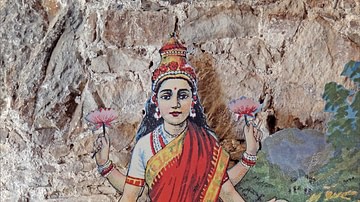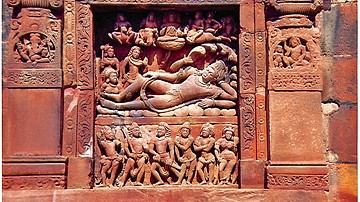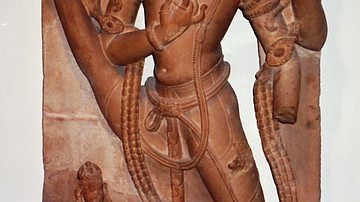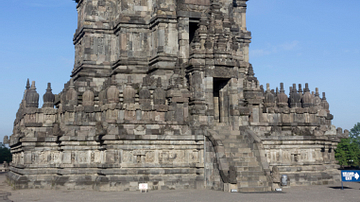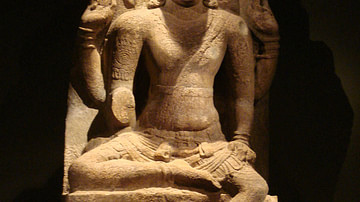Illustration
Vishnu with Lakshmi and Saravati, phyllite sculpture from West Bengal, India, 12th century.
The Hindu god Vishnu, the preserver of the universe, is flanked by two female figures. His sister Sarasvati, the patron goddess of knowledge and the arts, stands to his proper left, playing a stringed instrument called a vina, which is her distinguishing attribute. Vishnu's consort Sri Devi, or Lakshmi, the goddess of prosperity, stands to his proper right holding a fly-whisk. Vishnu holds his own attributes in his four hands: the upper right and left hands hold the weapons with which he strikes down his enemies, the club and discus; the lower left holds a conch shell war trumpet, the sound of which terrorizes his enemies; and the open lower right bears a lotus bud, a symbol of the universal life force and his role as preserver. A Sanskrit inscription on the base of this sculpture indicates that it was a gift to a Hindu temple and gives the donor's name. The inscription is flanked by a portrait of the donor and his wife to his right, and small image of the bird-man Garuda and Vishnu's mountain, to his left. 12th century CE and is likely made of phyllite. It comes from West Bengal, India.
Iris & B. Gerald Cantor Center for Visual Arts at Stanford University, Stanford, California.
About the Author
Cite This Work
APA Style
Wiener, J. B. (2018, January 16). Vishnu with Lakshmi and Saravati. World History Encyclopedia. Retrieved from https://www.worldhistory.org/image/7930/vishnu-with-lakshmi-and-saravati/
Chicago Style
Wiener, James Blake. "Vishnu with Lakshmi and Saravati." World History Encyclopedia. Last modified January 16, 2018. https://www.worldhistory.org/image/7930/vishnu-with-lakshmi-and-saravati/.
MLA Style
Wiener, James Blake. "Vishnu with Lakshmi and Saravati." World History Encyclopedia. World History Encyclopedia, 16 Jan 2018. Web. 28 Mar 2025.




